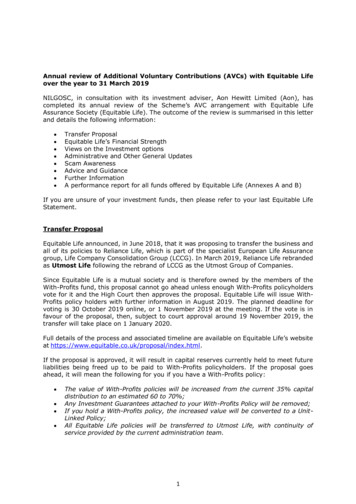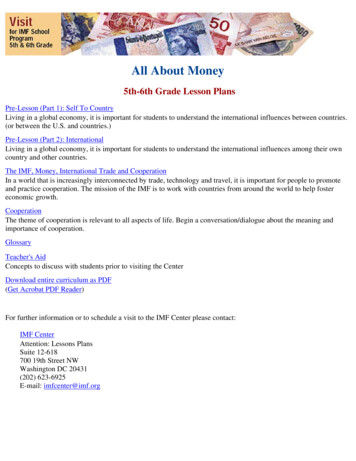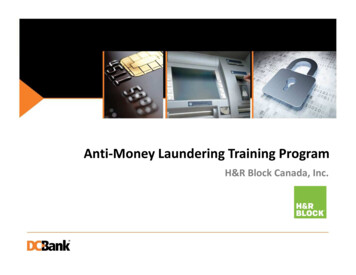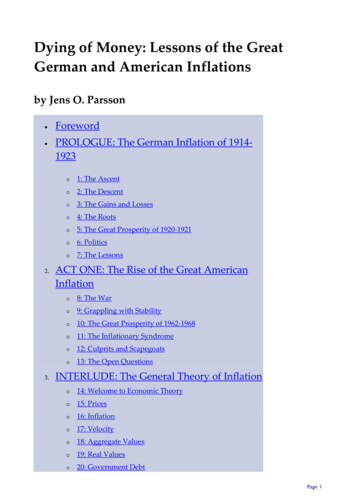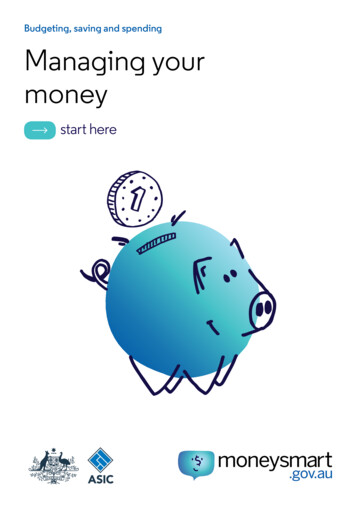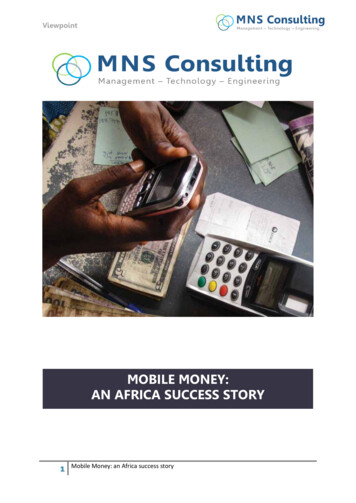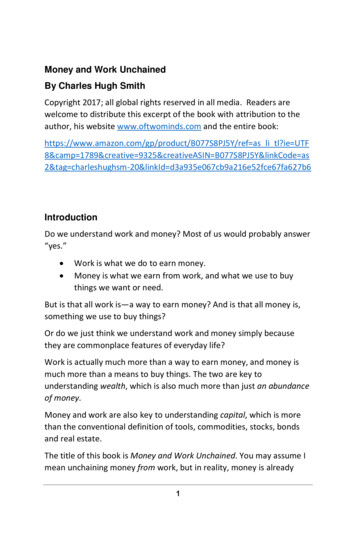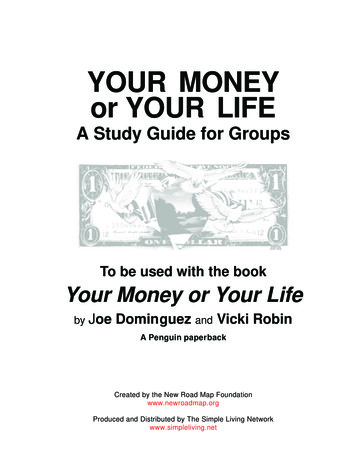
Transcription
YOUR MONEYor YOUR LIFEA Study Guide for GroupsTo be used with the bookYour Money or Your LifebyJoe Dominguez and Vicki RobinA Penguin paperbackCreated by the New Road Map Foundationwww.newroadmap.orgProduced and Distributed by The Simple Living Networkwww.simpleliving.net
A Special Note To Users Of This PDF EditionIf you downloaded this special, free PDF edition of the Study Guide and find ituseful, your financial contribution in any amount to the New Road MapFoundation and/or The Simple Living Network will be greatly appreciated.Your Money or Your Life: A Study Guide for Groups, to be used with the book Your Money or Your Life by JoeDominguez and Vicki RobinCopyright New Road Map Foundation 1996This Study Guide is available from The Simple Living Network (ordering information is provided in the back of thisvolume). If the need arises, however, permission to reproduce this Study Guide is granted, provided it is done in itsentirety and presented as a complete unit, and that credit is given to The New Road Map Foundation and The SimpleLiving Network.It is our hope that this Study Guide will serve you well. If you have any comments or suggestions, please feel free tocontact us.New Road Map FoundationP.O. Box 15981Seattle, WA 98115www.newroadmap.org2The Simple Living NetworkP.O. Box 233Trout Lake, WA 98650www.simpleliving.net
Can you soar like an eagle if you spend like a turkey?**One of New Road Map Foundation’s founders grew up on a turkey farm, and she attests to the fact thatdomesticated turkeys do drown themselves by running around with their mouths open when it rains. They don’t knowhow much is enough. Is it any wonder that the biggest shopping day of the year is the day after Thanksgiving?!3
ForewordWhat you have in your hands represents an important step in a longprocess. For you, it’s the choice to transform your lifelong relationship withmoney, with all its ups and downs, fears and hopes, successes and sorrows.For the New Road Map Foundation, this Group Study Guide is a new step inour commitment to transform the way Americans think about, spend andsave money.Since the publication of Your Money or Your Life in 1992, the New RoadMap Foundation has received countless requests from educators,corporations, unions, health-care providers, credit counselors and “just plainfolks” for a tool to guide groups who want to study — and implement! —the program.We developed and pilot tested this Study Guide in a corporate setting.What better location than the workplace to learn how to keep more of yourpaycheck! With the success of this pilot project behind us, we’ve developedthis expanded version that is great for any setting where people gather tolearn — community centers, adult education programs, high schools andcolleges, libraries and living rooms. (We’ve also developed a "Group StudyGuide for Contemporary Christians" and a "Group Study Guide on Moneyand Spirit." — Appendix B.)Everything you need to know to get a group going is explained in theIntroduction. If you would like to see a video of our introductorypresentation (taped at the pilot site, Weyerhaeuser Corporation in FederalWay, Washington), see page 49 for ordering information.Many valued colleagues added their genius to this Study Guide.Liesbeth Trappenburg gave invaluable input on content, as did Jane Hunt ongraphics. Readers of early versions include Paul Wilson, Dave Ellis, PeterMoore, Karen Nims, Barb Clagett, Dick Roy, Mike and Linda Lenich, EnidTerhune, David Heitmiller and Jacque Blix. To them — our gratitude.Thanks also go to Susan Mersereau, Chris Wooten, Debra Hansen, Steve Hill,Joy Troche and Tom Oswald of Weyerhaeuser for supporting thetest phase.We wish you well on your journey to a transformed relationshipwith money.Monica Wood, Editor4
ContentsForeword . 4Introduction . 6Facilitator List . 10Kick-off Session . 11Decide how your study group will operate; get to know each other. Begin Step 1.Session 1: Getting Started . 17Begin Step 2: Learn about your money behavior — keep track of every cent you spend.Session 2: Getting Out of the Money Trap . 21What do you have to show for what you’ve earned? Continue Step 1: Inventory your stuff.Session 3: What Is Money?. 27Find out what money is and what it costs you. Continue Step 2: Track your life energy.Session 4: Knowing Where Your Money Goes . 31Begin Step 3: Develop categories for your spending; create a Monthly Tabulation.Session 5: Fulfillment and Purpose . 35Look at your life purpose. Begin Step 4: Ask questions that can change your life.Session 6: Making Life Energy Visible . 39Begin Step 5: Plot your income and expenses on a chart; put it where you will see it every day.Follow-up Session: Looking at Your Progress . 43Reflect on your experiences and celebrate your progress.Appendix A: Additional Discussion Questions. 46Appendix B: Resources . 48Appendix C: Feedback Form . 495
IntroductionWelcome!You’ve made an important choice: to transform your relationship with money.This Study Guide will help you start implementing the program in Your Money or YourLife. Using both this Guide and Your Money or Your Life, your group sessions will be fastpaced, provocative and enjoyable.What Is Your Money or Your Life?Your Money or Your Life is the best-selling book by Joe Dominguez and Vicki Robin(New York: Viking Penguin, 1992). It presents a simple, nine-step plan that will transform the way you think about, earn and spend money. This plan, a whole-systemsapproach based on simple record-keeping and your own unique life situation, worksfor anyone who earns or spends money. Singles and couples (with and without children), retirees and students, big earners and those below the poverty line have allbeen successful in doing the program.What Are the Results of the Nine-Step Program?After following the steps for six months, people report that they have reducedtheir expenses an average of 20 percent, are paying off debt and building savings —and are enjoying a higher quality of life. Couples and families also gain a way to talkabout money and make new decisions. There is a sense of discovery and aliveness ashabits are questioned and old dreams are renewed. All of this can happen for you.This Study Guide is designed to give you the best start possible in understanding andusing the steps.Why Group Study?This Study Guide harnesses the creative energy and effectiveness of grouplearning to help you improve your relationship with money. It will guide your groupthrough a process — using exercises, reflection, discussion, and homeworkassignments — that will launch you on your journey.Note, however, that most people who have implemented this program have doneso on their own. The added support of a group can help you get started, but the realwork on the program happens as you continue doing the steps on your own, or withyour family.6Introduction
Purpose of the Study GuideBy following this Study Guide, reading Your Money or Your Life and doing thehomework assignments, you will begin to implement the first five steps in the nine-stepprogram and anchor these key steps in your life.In the process you will: explore your relationship with money understand better the relationship between money and work begin to discover what is “enough” for you change habits, and possibly begin making major life changesHere are two keys to making this system work for you:1. Start.2. Keep going.The objective of these sessions is not to finish. The objective is to begin.Planning Your GroupThis Study Guide takes you through the following sessions: Kick-off session (one hour) Six weekly, one-hour sessions Follow-up session after you’ve completed a second month of implementing the stepsIf possible, schedule your Kick-off session in the middle of the month so you canstart the new month with one of the basic steps of the program: tracking your expenses. This will give you time to generate the data you will be using in latersessions.This Study Guide can be adapted to accommodate other meeting schedules: Two-hour weekly sessions Sessions every other weekFor groups choosing to have longer sessions, we have included additional topicsfor discussion at the end of the Study Guide (see Appendix A, page 47). Meeting everyother week allows participants more time to complete homework assignments.Group Size: Optimal group size is about twelve people. If you have fewer thanfive, you might want to invite more to join. If you have more than twenty, considerdividing into two groups.Tools Needed: Each group member needs a copy of Your Money or Your Life andthis Study Guide. The person who convenes the group will bring the Study Guides tothe Kick-off session (see ordering information on page 49).Introduction7
For Individuals Too?Though the primary purpose of this Study Guide is to facilitate group learning, itcan be used for individual study. Simply respond to all group discussion questions in anotebook. If you wish, reflect on the supplementary questions in Appendix A.FacilitationThe Kick-off session is facilitated by the person who brings the group together.For subsequent sessions, facilitation rotates among other group members. The StudyGuide is designed to make facilitation easy and enjoyable, even for people who havenever led groups. The facilitator’s specific tasks will be reviewed during the Kick-offsession (see page 12), at which time volunteers will sign up.FormatEach session includes: Overview of the session “Group Check-in”: a chance to talk about your experience of doing the previous session’s assignments Individual exercise(s) Group discussion (Note: Discussions may be done in subgroups if your studygroup is large.) Assignments for the next sessionA suggested length of time is given for each activity.The Kick-off and Follow-up sessions have slightly different formats.How to Make Your Study Group a SuccessA list of helpful guidelines will be reviewed by participants during the Kick-offsession (see page 13).8Introduction
Frequently Asked QuestionsCan I do this program without my spouse or partner?You can use this study group to get started. If you are part of a larger household, treatyourself, for now, as an individual entity. You will probably want to engage the rest ofyour family over time. As you do the assignments, consider your own finances separately to the extent that you can. Simply do what makes the most sense to you. Thereis no “right” way.What if I fall behind the rest of the group?Continue coming to the meetings. You can gain a lot by participating in the exercisesand discussions and by doing assignments at home as you have time.Introduction9
Facilitator ListAt your Kick-off session, have different group members volunteer to facilitate each session.Note that the Follow-up session takes place one month after Session 6.Session123456Follow-up(one month later)10NameDate
Kick-off SessionDecide how your study group will operate; get to knoweach other. Begin Step 1.Tools You Need for this SessionA copy of Your Money or Your Life, this Study Guide, pen or pencilGroup Introductions (5 minutes)Facilitator asks participants to introduce themselves by name and sayone word that describes their relationship with money.Group Check-in (10 minutes)Facilitator reads the following question aloud; go around the circle until everyone hashad a chance to respond. (Please ask participants to avoid commenting on whatothers say during each session’s opening Check-in.)What do you want to gain or change by joining this study group and following the steps in Your Money or Your Life?(Suggestion: Set your sights high and be specific regarding your goals.)Kick-off Session11
Launching Your Group (20 minutes)Facilitator guides the group through the following:Schedule Meeting TimesThis Study Guide is designed to be used in six one-hour weekly sessions,plus this Kick-off session and a Follow-up session one month later. If possible, schedule your next session during the last week of the month so youcan start the new month with one of the basic steps of the program: tracking your monthly expenses. Set meeting dates accordingly and write themon page 10. (As reviewed in the Introduction on page 7, this Study Guidecan be adapted for different schedules. If decisions need to be made regarding these options, do so now.)FacilitationThis is a self-facilitated program with rotating leadership, and volunteers forthe remaining sessions are needed at this time. When you facilitate, yourjobs are to: Introduce exercises as directed in this Study Guide. Make sure everyone understands the information presented. Keep the discussion focused on the topic; if people get off track, gentlyhelp the group refocus. (For example, say, “That’s an interesting idea, butit’s taking us off the topic. Perhaps you could talk further with someoneabout it after the meeting.”) Make sure everyone has a chance to participate — as a speaker and as alistener. Conduct group discussions by going around the circle, givingeach participant the option to speak or pass. Or simply open the floor towhoever wishes to speak; as conversation winds down ask if anyone elsewishes to speak. Keep track of time, letting everyone know when there is only one minuteleft for a given exercise. Step out of your facilitator role when it’s your turn to respond to adiscussion question.Write names of volunteer facilitators on page 10.12Kick-off Session
Guidelines for Making Your Group a SuccessFacilitator asks group members to read these guidelines silently. Ask for each groupmember’s agreement on the guidelines before proceeding. Attend each meetingEach session builds on previous sessions, so your presence is important.Furthermore, each person brings a unique and valuable perspective, soyour participation will affect the outcome for all. If you are unable toattend a meeting, inform that session’s facilitator. Do the homework assignmentsYou will benefit from doing the assignments — and the group will benefitfrom your full participation. If you cannot complete the reading andassignments before the next session, at least read the key pages that areindicated, and come to the next group meeting anyway. Do the stepsDo the steps as they are presented in Your Money or Your Life. While othermethods may work, your purpose here is to learn this method, which has aproven track record for producing significant results. The steps reinforceeach other and work best when you do all of them. Offer each other absolute confidentialityMoney is one of the most intimate and difficult topics to discuss. You mayreveal more about your personal relationship with money here than you everhave before. Let nothing that is said in this group go beyond those present. Participate openlyBe as open and honest as possible, while always respecting any groupmember’s choice not to speak. Note: At no point are group membersrequired to reveal any personal financial data. Participate activelyFeel free to speak up, while ensuring that others also have opportunitiesto speak. Every question and comment is important, and every contribution is appreciated. Both speaking and listening enliven the group. Support your facilitatorGroups can get waylaid by people who wander away from the topic, interrupt, complain or talk too much. Support your facilitator in keeping thegroup focused on the topic. Start and end on timeBy beginning and ending at your agreed-upon time you demonstraterespect for all participants. Have fun!Kick-off Session13
Begin Step 1: Find Out How Much Money You HaveEarned in Your Lifetime14 GoalMake peace with your past in the area of money. Why?Taking a look at your past relationship with money clears the slate forbuilding a healthier relationship in the present and sheds light on yourearning power. How?Start looking at how much money you’ve made in your life.Kick-off Session
Exercise: Making Peace with Your Past (10 minutes) (individual)Your homework assignment includes contacting Social Security to find outhow much money you have made in your lifetime. Use the space below tobegin listing past employment that would not have been reported to SocialSecurity, such as jobs you had as a youth (e.g., delivering newspapers, babysitting, bagging groceries).Write down how much money you think you’ve made in your lifetime: Facilitator: When time is up for this exercise, direct group members’ attention to theassignments on the next page.Kick-off Session15
Looking AheadReading Assignment for the next session Study Guide Introduction (pp. 6-9) From Your Money or Your Life: Prologue From Chapter 1:pp. 30-33: How Much Have You Earned in Your Life?Action Assignment for the next session To begin Step 1, write to Social Security for your Statement of LifetimeEarnings (see p. 30 of Your Money or Your Life) or call 1-800-772-1213. See page 10 of this Study Guide to check the date and facilitator of thenext session.Bring Next SessionPen or pencil, Your Money or Your Life, Study Guide This program has been, in a word, “profound.” It has nowstarted to impact every facet of our life. Our life has becomenot only much “richer” but more deliberate, as we becomemore aware of our values and choose to live by them. Theprogram has opened up many options for our life. We havebecome more at peace with money.– Couple from Ohio16Kick-off Session
Session 1: Getting StartedBegin Step 2: Learn about your money behavior — keep track of every centyou spend.Overview of the Session GoalBegin gathering the information you’ll need to make the changes youdesire in your financial attitudes and behavior. Why?To transform your relationship with money, it is important to observeboth your attitudes and your behavior. By beginning Step 2, “Tracking YourExpenses,” you will generate the records you’ll need for later assignments.One key to the nine-step program is understanding that you sell your mostprecious resource, your time, for money. Spending your money well begins withknowing where it’s going. How can you make ends meet if you don’t knowwhere the ends are? How?Begin keeping a record of every cent you spend.Tools to BringPen or pencil, Your Money or Your Life, Study GuideInstructions for the Facilitator Remind everyone to: Keep what is said in confidence Respect anyone’s choice not to respond to any particular question Keep track of time, letting everyone know when there is only one minuteleft for a given exercise.Session 1: Getting Started17
Group Check-in (20 minutes)Facilitator reads aloud: (Please ask participants to avoid commenting on what otherssay during each session’s opening Check-in.)Tell about one item you bought recently that you feel good about, and why.Exercise: Tracking Your Expenses (15 minutes) (individual)Facilitator: Make sure everyone understands this step.In order to start a new relationship with money and enjoy the benefitspromised by Your Money or Your Life, it is essential to gather informationabout your current spending patterns. One of your homework assignmentsis to begin recording every cent that comes into and goes out of your life.Later you will organize these expenses into categories and compute amonthly total.On the next page is a list of typical expenses. Beside each item write howyou normally pay for it and how you intend to keep track of it (e.g., checkregister, pocket or purse notebook, collect receipts). This list is to get youthinking; it is not intended to be complete. Also, note that over time you mayrefine your method of tracking expenses.Facilitator: When there are 5 minutes left, ask if there was any type of expense thatany group member couldn’t imagine tracking. Allow others to suggest solutions.18Session 1: Getting Started
How I normally payHow I will track this expenseRent/House paymentUtilitiesPhoneHealth insuranceAuto insuranceGroceriesClothesGas for carBus/ParkingDry cleaningDay careMovies/TheaterRestaurant mealsCharitable contributionsGiftsOtherGroup Discussion (10 minutes)Note: If there are more than eight in your study group, you may wish todivide into subgroups for each session’s Group Discussion. We recommendthat these small groups remain the same for the duration of the course.Facilitator reads the questions one at a time, allowing time for discussion after eachquestion. How do you think keeping track of your expenses might affect yourbuying habits? What strengths (personal and other) can you draw on to help you keeptrack of every cent?If you divided into small groups, regroup and report on your discussions toeveryone.Session 1: Getting Started19
Looking AheadNote: All page numbers in the assignments refer to Your Money or Your Lifeunless otherwise indicated.Reading Assignments Chapter 1If you are short on time, at least read pp. 12-13 and pp. 23-28. From Chapter 2:pp. 55-56: Your Life Energypp. 69-74: Keep Track of Every CentAction Assignments To begin Step 2, decide how you are going to track your expenses and getthat system ready to go. Start tracking your expenses.Begin this step as soon as possible so you can have a complete month of expenses to work with by Session 5.Bring Next Session The system you are using to track expenses Pen or pencil, Your Money or Your Life, Study GuideYour journey has begun! You’re setting up systems that can bring measurable changes in how you spend your most precious resource, your lifeenergy. Reminder: The key to success lies in doing the steps. I have a handle on how much money I have, how I spend itand where it is. No more money worries based on nebulousfears. My savings have increased from 4,815 to 10,550.And I have a whole new attitude! I’ve transformed myrelationship with money.– Woman from Hawaii, decreased expenses 335/month20Session 1: Getting Started
Session 2: Getting Outof the Money TrapWhat do you have to show for what you’ve earned?Continue Step 1: Inventory your stuff.Overview of the Session GoalTake stock of what you have — and what it has cost you to have it. Why?Full accountability to yourself for your possessions, your savings and yourdebts opens up the opportunity for improvement in how you earn, spendand save money. The first exercise of this session will get you going in theassessment process. How?Begin observing and reflecting on your possessions.Tools to Bring The system you are using to track expenses Pen or pencil, Your Money or Your Life, Study GuideInstruction for the FacilitatorThis session is a full one, and it will be especially important to stay on trackand on time.Session 2: Getting Out of the Money Trap21
Group Check-in (15 minutes)Facilitator reads aloud:What was most exciting or eye-opening for you in tracking your expenses?Exercise: Fulfillment Curve (10 minutes) (individual)In the chart below, write down some of your possessions and evaluate themaccording to the following categories: Survival, Comfort, Luxury or Clutter(if needed, see pp. 23-27 of Your Money or Your Life for a review of the Fulfillment Curve). You may continue this exercise at home if you wish.Item22Session 2: Getting Out of the Money TrapSurvivalComfortLuxuryClutter
Exercise: A Walk Through Your House (10 minutes)Facilitator: Have everyone sit comfortably, with eyes closed if they wish, and lead themon an imaginary walk through their homes. Read the following slowly, pausing aftereach sentence. (Hint for facilitator: pause long enough for each image to come to yourmind.)Picture your house or apartment building from the street or outside. Enter your home through the door you normally use. What room are youin? If you are not already there, go to your living room or front room. What furniture is in it? Can you remember acquiring each piece? Doyou need all of it? Put a price tag on each piece. What’s on the walls? What values does this room reflect? What items do you enjoy? What’sclutter? Now go to your kitchen. How do you feel when you enter this room? Are there things on the counters or are they clear? What’s visible? Open the cupboards. What do you see? What appliances do youown? How often do you use each one? What items could you dowithout? Go into your bedroom. What do you notice first? Open your closet. What do you see? How often do you wear each piece of clothing? Arethere items you could do without? Think about your entire house. Arethere too many things? Not enough? What does your house representto you? Open your eyes and continue with the next exercise.Session 2: Getting Out of the Money Trap23
Exercise: Reflection (3 minutes) (individual)In the More column list what you would like more of; in the Less column listwhat you would like less of.More24LessSession 2: Getting Out of the Money Trap
Group Discussion (10 minutes) (small groups if desired)Facilitator (or someone in each small group) reads the questions one at a time,allowing time for discussion after each question. Which items would you like to see more of and which would you like tosee less of? Is one person’s more another person’s less?(Regroup and report on your discussions to everyone.)Session 2: Getting Out of the Money Trap25
Looking AheadReading Assignments Chapter 2If you are short on time, at least read pp. 41-42; pp. 44-48 (includingMoney as Social Acceptance); pp. 54-56 (start with bold text) and pp.59-67 (start with How Much ).Action Assignments Continue Step 1. Develop a method to inventory your possessions (see pp. 33-35). Begin your inventory. You may inventory one drawer, a closet, or even awhole room. (Your inventory does not have to be completed now — butdo begin it.) Continue tracking your expenses.Bring Next Session The inventory you’ve begun to take The system you are using to track expenses Pen or pencil, Your Money or Your Life, Study GuideCongratulations! You have completed Session 2 of your journey towardtransforming your relationship with money. By keeping focused on what really matters, I’ve eliminated many inessentials in my life. I’ve achieved remarkable financial clarity and confidence. The stepsand ideas presented in the program have helped me tobuild a life of love and fulfillment in the present.– Woman from California26Session 2: Getting Out of the Money Trap
?Session 3: What Is Money?Find out what money is and what it costs you. Continue Step 2: Track your life energy.Overview of the Session GoalFind out what you are trading your life energy for. Why?This process puts paid employment into real perspective and enables youto see how much you are actually making at your job. How?Calculate your real hourly wage.Tools to Bring The inventory you have begun to take The system you are using to track expenses Pen or pencil, Your Money or Your Life, Study GuideGroup Check-in (10 minutes)Facilitator reads aloud:Tell about what you inventoried — a drawer, a closet, a room — and whatinsights you gained.Session 3: What Is Money?27
Group Discussion (20 minutes) (small groups if desired)Read the questions silently and take 5 minutes to think about them. Spendthe next 15 minutes in group discussion.Facilitator: Let all groups know when there are 3 minutes of discussion time left. What did you learn about money as a child? Did your mother and father have different ideas about money?If so, which one did you tend to believe?Exercise: Developing a Life Energy vs. Salary Checklist(10 minutes) (individual)Because we trade our life energy for money, establishing the actual costs intime and money to maintain our jobs is a critical piece in evaluating ourrelationship to money.Using pp. 67-68 of Your Money or Your Life as your guide, begin filling outyour Life Energy vs. Salary Checklist on the next page. This will assist you inyour homework assignment: calculating your real hourly wage. Write down job-related spending categories that apply to your life. Fill in estimates of your time and money expenditures in each category.Note: If you are not currently employed, either estimate the job-relatedtime and money expenditures of the main breadwinner in your family orestimate from a period of time when you were employed. Future exercisesand assignments related to employment can be handled in the same way.The cost of a thing is the amount of what I will call life which isrequired to be exchanged for it, immediately or in the long run.– Henry David Thoreau28Session 3: What Is Money?
Checklist: Life Energy vs. SalarySpending CategoryTimehrs/week moreMoney /week lessGroup Discussion (5 minutes) (small groups if desired)Facilitator (or someone in each small group) reads aloud:As you became aware of hidden job-related costs, can yousee areas where you could reduce or even eliminate expenses immediately?(Regroup and report on your discussions to everyone.)Session 3: What Is Money?29
Looking AheadReading Assignments Chapter 3If you are short on time, at least read pp. 76-79 (start withBudgets ); pp. 81-87 and pp. 90-93 (start with Making ).Action Assignments Continue Step 2. Complete your Life Energy vs. Salary Checklist. Calculate your real hourly wage (see p. 64-65). A
Introduction 7 Purpose of the Study Guide By following this Study Guide, reading Your Money or Your Life and doing the homework assignments, you will begin to implement the first five steps in the nine-step
